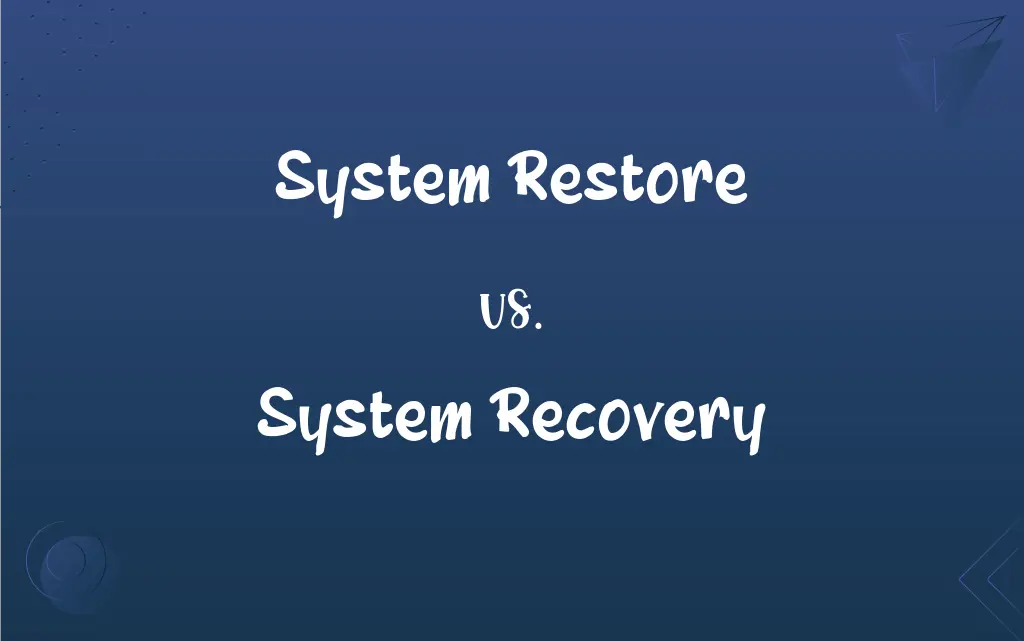System Restore vs. System Recovery: What's the Difference?
Edited by Janet White || By Harlon Moss || Updated on October 8, 2023
System restore reverts the computer’s system files to an earlier point without affecting personal files, while system recovery resets everything to factory settings, deleting all user data and applications.

Key Differences
The concepts of system restore and system recovery serve as life-savers for computer users dealing with system malfunctions. A system restore, generally speaking, is a feature that allows you to revert your computer's system files, settings, and applications to a previous point in time. In contrast, system recovery, also known as system reset or factory reset, removes all user data, applications, and settings, restoring the system back to its original factory settings, almost like initializing a fresh start.
Addressing user needs in different contexts, system restore is often utilized to rectify minor system issues and to roll back undesirable changes. This tool is particularly useful when a recently installed application or system update causes instability or malfunctions. Meanwhile, system recovery is a more drastic measure, typically employed when a system is critically compromised, either through significant file corruption, system failure, or even virus infestation, where a fresh start is imperative.
The ease of usage and impact on user data distinguish system restore and system recovery. System restore is generally quicker and focuses on reverting system files and applications without jeopardizing personal files. Conversely, system recovery is comprehensive and wipes everything—system settings, applications, and user data, ensuring that the system is returned to its original state, which can be likened to starting with a clean slate.
In practical scenarios, system restore is less intrusive and is frequently the first point of call when troubleshooting system issues since it does not affect user files and utilizes restore points to revert the system to a previous stable state. System recovery, being a thorough reset, is reserved for situations where system issues are irreparable, or when there’s a need to wipe the slate clean, possibly before selling or transferring the computer to a new user.
Lastly, while system restore might be employed often due to its non-destructive nature, system recovery is utilized sparingly due to its profound impact on user data and settings. It's pertinent that users understand the repercussions and distinctions of system restore versus system recovery to appropriately manage and troubleshoot system-related issues, safeguarding their data and ensuring system stability when possible.
ADVERTISEMENT
Comparison Chart
User Data
Does not affect personal files
Erases all user data
Applications/Settings
Reverts applications/settings
Resets all applications/settings
Use Case
Used for minor system issues
Used for critical system failures
Duration
Typically quicker
Can be time-consuming
Impact on System
Low-impact, reverses to a previous state
High-impact, resets system to factory state
ADVERTISEMENT
System Restore and System Recovery Definitions
System Restore
A method to fix minor system issues by using restore points.
I utilized system restore to retrieve the settings from two days ago after an unstable update.
System Recovery
A method to reinstall the operating system, typically removing all additional data.
After a critical error rendered my PC unusable, system recovery was deployed to reinstall Windows.
System Restore
A process of returning the computer to a previous operational state.
The virus disrupted my settings, so I performed a system restore to a point last week.
System Recovery
A tool for remedying severe system malfunctions or corruptions.
Following a stubborn malware attack, I had to undertake a system recovery to eradicate all traces.
System Restore
A utility to undo recent system changes without impacting personal files.
To resolve the unexpected crashes, I executed a system restore to a stable point.
System Recovery
A mechanism to erase all user data, applications, and settings.
To sell my old laptop, I executed a system recovery to ensure the new owner received it as new.
System Restore
A tool that reverts system files and settings.
When the software update caused errors, I used a system restore to revert the changes.
System Recovery
A process that resets a computer to its original factory settings.
When my computer was persistently crashing, I performed a system recovery to start afresh.
System Restore
A feature that allows users to reverse system alterations.
To maintain my personal files while undoing the application installations, I chose to initiate a system restore.
System Recovery
A comprehensive reset to restore the system to its initial state.
When passing the desktop to my sibling, I utilized system recovery to provide a clean slate.
FAQs
Does system recovery improve performance?
System recovery can improve performance by providing a clean slate but doesn’t guarantee fixing all hardware-related issues.
Will system recovery erase all my documents and apps?
Yes, system recovery will delete all your documents, apps, and settings, providing a fresh start.
How often should I perform system recovery?
System recovery is typically a last resort and should be performed sparingly, only in critical scenarios.
Does system restore delete my files?
No, system restore does not delete personal files but reverts system files and settings.
In what scenario is system recovery necessary?
System recovery is generally used in situations of critical system failure, persistent issues, or when giving/selling the computer to another user.
How long does system recovery typically take?
System recovery can take several minutes to hours, depending on system specifications and data volume.
Can system restore fix hardware issues?
No, system restore reverts software settings and will not fix hardware problems.
How can I prevent data loss during system recovery?
Ensure to back up all vital data externally or using cloud storage before performing a system recovery to prevent data loss.
What is system restore?
System restore is a tool that allows you to revert your computer’s system files and settings to a previous point without affecting personal files.
What does system recovery involve?
System recovery involves erasing all data and settings on a computer, restoring it to its original factory state.
How do I perform a system restore?
System restore is typically accessible via the Control Panel or System Protection settings on your computer.
Can I choose a specific restore point in system restore?
Yes, you can select from available restore points, choosing a specific date and time to revert the system to.
Can I undo a system restore?
Yes, an undone system restore can typically be reversed, restoring files and settings to their post-restoration state.
Is system recovery reversible?
No, system recovery is not reversible and permanently deletes all user data and settings.
Can I retrieve my files after a system recovery?
Unless you’ve backed up your data externally, system recovery permanently deletes all files and cannot be undone.
When should I use system restore?
System restore is typically used to fix minor system issues or reverse undesirable system changes without affecting user data.
Will system recovery update my operating system?
System recovery restores the OS to the version initially installed on the computer, not necessarily the latest version.
Can I perform system restore without booting into Windows?
Yes, you can perform system restore from the Windows Recovery Environment without booting into Windows.
Does system restore remove viruses?
System restore might remove system changes made by a virus but doesn’t guarantee virus removal.
Is it safe to do a system restore?
Generally, system restore is safe and doesn’t cause data loss but can occasionally introduce system issues.
About Author
Written by
Harlon MossHarlon is a seasoned quality moderator and accomplished content writer for Difference Wiki. An alumnus of the prestigious University of California, he earned his degree in Computer Science. Leveraging his academic background, Harlon brings a meticulous and informed perspective to his work, ensuring content accuracy and excellence.
Edited by
Janet WhiteJanet White has been an esteemed writer and blogger for Difference Wiki. Holding a Master's degree in Science and Medical Journalism from the prestigious Boston University, she has consistently demonstrated her expertise and passion for her field. When she's not immersed in her work, Janet relishes her time exercising, delving into a good book, and cherishing moments with friends and family.
































































